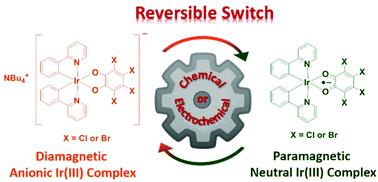Electrochromic behaviour of Ir(iii) bis-cyclometalated 1,2-dioxolene tetra-halo complexes: fully reversible catecholate/semiquinone redox switches†
Abstract
Neutral cyclometalated Ir(III) complexes of general formula [Ir(ppy)2(O^O)squi], where ppy = 2-phenylpyridine and (O^O)squi = TBC (tetrabromocatechol) or TCC (tetrachlorocatechol) in their semiquinone (squi) monoanionic redox state, were synthesized by chemically oxidizing the anionic parent complexes NBu4[Ir(ppy)2(O^O)cat], in which (O^O)cat represents the corresponding ancillary dioxolene ligand in its dianionic catecholate (cat) redox state. This chemical oxidation leads to the modification of both the photophysical and the magnetic properties of the complexes. While the NBu4[Ir(ppy)2(O^O)cat] complexes are diamagnetic (D) and yellow-orange solids, the corresponding oxidized complexes [Ir(ppy)2(O^O)squi] display paramagnetic (P) properties and are characterized by a dark-green color. The conversion between the two forms (squi vs. cat) is electrochemically and chemically fully reversible. Indeed, the anionic NBu4[Ir(ppy)2(O^O)cat] complexes are quantitatively restored by chemical reduction of the neutral [Ir(ppy)2(O^O)squi] parents. These complexes therefore represent interesting redox based switches between multi-parameter states since they allow switching from a neutral paramagnetic to an anionic diamagnetic form together with a significant change in chromicity. Taking advantage of the significant color difference between the oxidized and the reduced form, an electrochromic cell was prepared with [Ir(ppy)2(TBC)squi] and its spectroelectrochemical properties are reported.



 Please wait while we load your content...
Please wait while we load your content...